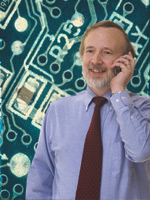
 Allen Glisson and his colleagues have found ways to speed development of new PCBs, which grow more complex as cell phones and other portable devices get smaller.
Allen Glisson and his colleagues have found ways to speed development of new PCBs, which grow more complex as cell phones and other portable devices get smaller.
Engineers often relish such challenges, perhaps because they offer opportunities to employ creativity and novel tactics. That’s exactly how electrical engineers Allen Glisson and Ahmed Kishk—along with graduate student Mohammed Rajeek Abdul-Gaffoor and his supervisor, Motorola engineer Hugh Smith—approached the problem of modeling sophisticated printed circuit boards often used in multifunction electronic devices such as cell phones and personal digital assistants.
Their solution, which has been praised for its simplicity, may help manufacturers speed new high-tech products to market while keeping development costs down.
“As devices become more compact—with cell phones and other portable devices—you have to layer circuits on top of one another to handle more wiring, in effect,” says Glisson, honored as one of the world’s most-cited computer science writers by ISIHighlyCited.com. “But the smaller you make the PCBs—the smaller the layers and the closer you pack them—the more likely you are to have wave effects, which create unwanted coupling between two or more circuits in a board. These coupling effects can be transmitted through the board material or through air via magnetic fields.”
The problem is compounded by the size of new PCBs. Models used in the latest multifunction cell phones measure only about 1 x 2 x 1/8 inches, roughly half the size of a saltine cracker. Each board may contain up to seven layers, with hundreds or even thousands of electrical connections between the layers and, thus, hundreds of possibilities for interference.
Designers need to be able to accurately model the behavior and performance of circuits in a PCB so they can analyze them without building prototypes for physical testing. “The more accurately you can model and understand what’s going on in the circuit, the shorter and less expensive the design cycle will be,” Glisson says. “But as circuits get more complex, we are exceeding the computational power that’s available.”
The standard modeling method is to make a mathematical grid model of the metallic surfaces, or traces, on a board and then plug in values for the electrical energy that will be applied. By solving a matrix to determine the current values on the board traces, designers can learn whether the circuits perform as intended.
But in multilayer boards, the dielectric material between layers and the amount of metal in the traces causes problems, Glisson says. So as circuits become smaller in size and more complex, traditional analysis methods have become more time-consuming, taxing even powerful supercomputers to solve a single matrix.
To find a faster, more efficient way to model and analyze these circuits, the team decided to try a different approach, examining—in an electrical sense—what is not there rather than what is.
“Instead of modeling the metal layers, we modeled the gaps between the metal,” Glisson says. “By modeling the gaps, we can isolate the layers and work with smaller matrices when we’re calculating the values for the current. The matrices are still large, but they contain lots of zero values because of the isolation between the layers of the model. This allows the designers to solve them by elimination rather than calculating values.”
Another breakthrough came when Kishk suggested a method to feed the simulated circuits with current at different points without recomputing the entire matrix. Traditional methods require designers to recompute any time the point where energy enters the circuit, called an excitation point, changes.
The new methods have cut computation times from days to mere hours. Motorola has analyzed some circuits in as little as two hours, Glisson says. The researchers published their results in the journal IEEE Transactions on Microwave Theory and Techniques and were rewarded with the 2004 Microwave Prize for best paper.
The UM researchers hope to get the original code for the project from Motorola, or to replicate it. The method has potential in a variety of studies of large, complex circuits, Kishk says.
“The code was developed to design printed boards for cellular phones, which are very complicated and consist of several layers,” Kishk says. “This code can be extended to design transceiver microwave circuits, which can be used with our work on radar power technology.”